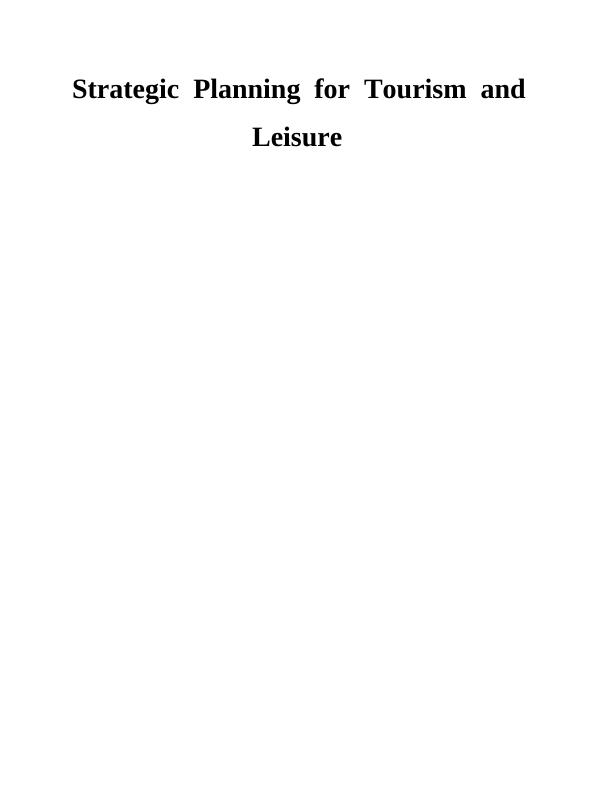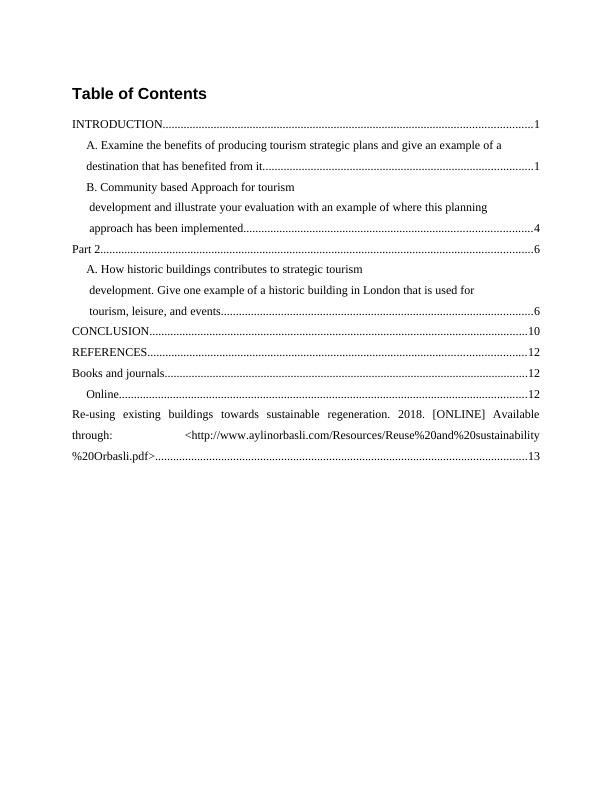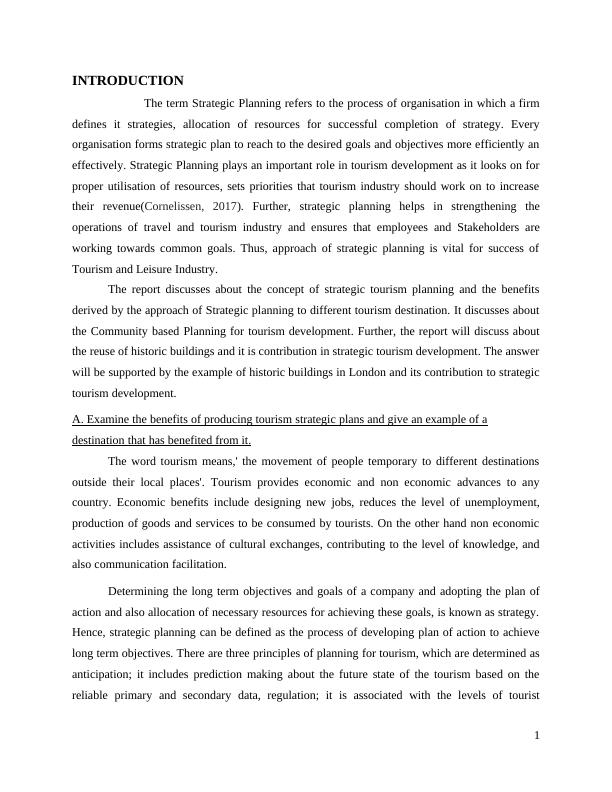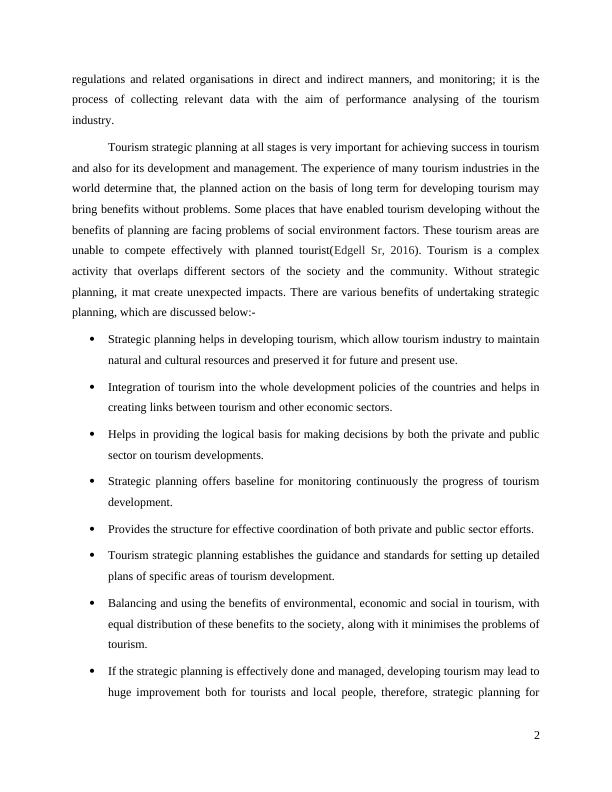Strategic Planning for Tourism and Leisure - Doc
Added on 2020-10-22
15 Pages4745 Words64 Views
Strategic Planning for Tourism and Leisure

Table of ContentsINTRODUCTION...........................................................................................................................1A. Examine the benefits of producing tourism strategic plans and give an example of adestination that has benefited from it..........................................................................................1B. Community based Approach for tourismdevelopment and illustrate your evaluation with an example of where this planningapproach has been implemented................................................................................................4Part 2................................................................................................................................................6A. How historic buildings contributes to strategic tourismdevelopment. Give one example of a historic building in London that is used fortourism, leisure, and events........................................................................................................6CONCLUSION..............................................................................................................................10REFERENCES..............................................................................................................................12Books and journals.........................................................................................................................12Online........................................................................................................................................12Re-using existing buildings towards sustainable regeneration. 2018. [ONLINE] Availablethrough:<http://www.aylinorbasli.com/Resources/Reuse%20and%20sustainability%20Orbasli.pdf>............................................................................................................................13

INTRODUCTIONThe term Strategic Planning refers to the process of organisation in which a firmdefines it strategies, allocation of resources for successful completion of strategy. Everyorganisation forms strategic plan to reach to the desired goals and objectives more efficiently aneffectively. Strategic Planning plays an important role in tourism development as it looks on forproper utilisation of resources, sets priorities that tourism industry should work on to increasetheir revenue(Cornelissen, 2017). Further, strategic planning helps in strengthening theoperations of travel and tourism industry and ensures that employees and Stakeholders areworking towards common goals. Thus, approach of strategic planning is vital for success ofTourism and Leisure Industry. The report discusses about the concept of strategic tourism planning and the benefitsderived by the approach of Strategic planning to different tourism destination. It discusses aboutthe Community based Planning for tourism development. Further, the report will discuss aboutthe reuse of historic buildings and it is contribution in strategic tourism development. The answerwill be supported by the example of historic buildings in London and its contribution to strategictourism development. A. Examine the benefits of producing tourism strategic plans and give an example of adestination that has benefited from it.The word tourism means,' the movement of people temporary to different destinationsoutside their local places'. Tourism provides economic and non economic advances to anycountry. Economic benefits include designing new jobs, reduces the level of unemployment,production of goods and services to be consumed by tourists. On the other hand non economicactivities includes assistance of cultural exchanges, contributing to the level of knowledge, andalso communication facilitation. Determining the long term objectives and goals of a company and adopting the plan ofaction and also allocation of necessary resources for achieving these goals, is known as strategy.Hence, strategic planning can be defined as the process of developing plan of action to achievelong term objectives. There are three principles of planning for tourism, which are determined asanticipation; it includes prediction making about the future state of the tourism based on thereliable primary and secondary data, regulation; it is associated with the levels of tourist1

regulations and related organisations in direct and indirect manners, and monitoring; it is theprocess of collecting relevant data with the aim of performance analysing of the tourismindustry. Tourism strategic planning at all stages is very important for achieving success in tourismand also for its development and management. The experience of many tourism industries in theworld determine that, the planned action on the basis of long term for developing tourism maybring benefits without problems. Some places that have enabled tourism developing without thebenefits of planning are facing problems of social environment factors. These tourism areas areunable to compete effectively with planned tourist(Edgell Sr, 2016). Tourism is a complexactivity that overlaps different sectors of the society and the community. Without strategicplanning, it mat create unexpected impacts. There are various benefits of undertaking strategicplanning, which are discussed below:- Strategic planning helps in developing tourism, which allow tourism industry to maintainnatural and cultural resources and preserved it for future and present use. Integration of tourism into the whole development policies of the countries and helps increating links between tourism and other economic sectors. Helps in providing the logical basis for making decisions by both the private and publicsector on tourism developments. Strategic planning offers baseline for monitoring continuously the progress of tourismdevelopment. Provides the structure for effective coordination of both private and public sector efforts. Tourism strategic planning establishes the guidance and standards for setting up detailedplans of specific areas of tourism development. Balancing and using the benefits of environmental, economic and social in tourism, withequal distribution of these benefits to the society, along with it minimises the problems oftourism. If the strategic planning is effectively done and managed, developing tourism may lead tohuge improvement both for tourists and local people, therefore, strategic planning for2

End of preview
Want to access all the pages? Upload your documents or become a member.
Related Documents
Tourism Strategic Managementlg...
|14
|4985
|188
Strategic Planning Assignment - (Doc)lg...
|15
|4833
|177
Strategic Planning for Tourism and Leisurelg...
|24
|6645
|358
Strategic Planning for Tourism and Leisurelg...
|13
|4968
|91
Tourism Strategic Plans (Doc)lg...
|15
|5023
|271
Strategic Planning for Tourism and Leisure Assignmentlg...
|15
|5324
|248
